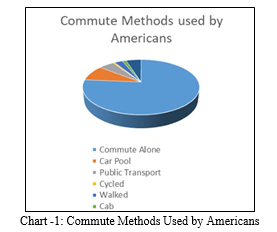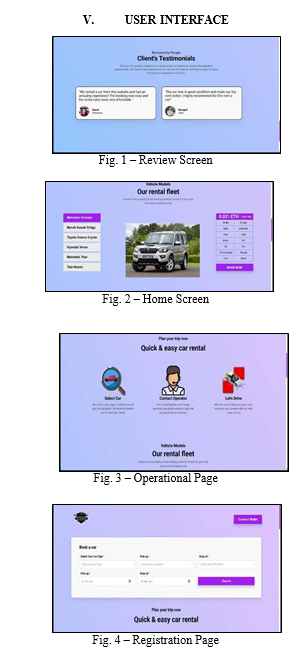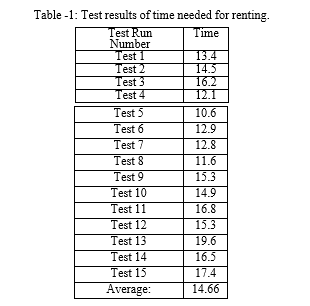Ijraset Journal For Research in Applied Science and Engineering Technology
- Home / Ijraset
- On This Page
- Abstract
- Introduction
- Conclusion
- References
- Copyright
Blockchain-Based Car Rental Platform
Authors: Aman Dwivedi, Divyansh Sharma, Sharad Gumber, Satyam Gupta
DOI Link: https://doi.org/10.22214/ijraset.2024.62979
Certificate: View Certificate
Abstract
Carpooling has seen a significant upsurge in popularity in recent years since it relieves commuters of the burden of driving a car and later spares them from the mad dash to locate a parking space. The industry now uses centralised database servers, which puts the system at risk of hacking, causes data leaks, and undermines security within the system. Additionally, there is a chance that the owner will misuse the data in a centralised system. Since the newly developed Blockchain technology provides complete anonymity and database transparency, data security and traceability may be guaranteed across the entire server. The goal of the suggested solution is to create and implement a blockchain-based, smart contract-based peer-to-peer vehicle sharing system. The Solidity programming language is utilised to carry out the smart contracts. Ethereum blockchain is used in the ecosystem\'s construction. Eliminating the middleman would result in a peer-to- peer (P2P) car-sharing programme, which would reflect decreased costs and exposure to data theft.
Introduction
I. INTRODUCTION
This research paper presents a novel approach to car rental administrations by incorporating blockchain innovation for improved security, straightforwardness, and productivity. The proposed framework utilizes blockchain to store basic information, counting rental assertions, vehicle utilization history, and client qualifications, guaranteeing tamper-proof and irrefutable records. Smart contracts on the Ethereum blockchain computerize the rental handle, from booking to vehicle return, lessening the requirement for mediators and minimizing potential debate. Installments are encouraged through MetaMask, permitting clients to create consistent and secure cryptocurrency exchanges. This integration addresses predominant issues in conventional car rental administrations, such as extortion, information control, and installment delays. The research incorporates the plan and usage of a model framework, illustrating the possibility and focal points of blockchain-enabled car rentals. Testing and assessment of the model highlight critical changes in operational straightforwardness, exchange security, and client beliefs. This study underscores the transformative potential of blockchain in modernizing the car rental industry and offers an outline for future advancements in blockchain-based benefit stages.

This is not a new idea, and this is not the first article written about it. We had the idea while speculating about possible real-world uses for blockchain technology. Many large companies are attempting to adjust to the idea of peer-to-peer vehicle sharing. A few have perfected the philosophy, and Lyft, a 2012-founded, publicly traded firm based in the USA, is one of the largest. Their mission was to reduce travel costs and improve living conditions in cities.
The fundamental idea behind all of this is that users can earn some money while not using their cars, and riders can save a significant amount of money by delaying the need to purchase a car. Unfortunately, providing customers with this kind of service entails numerous security risks, the first of which is to the service's general stability.
A centralised server would fail as a whole because of DDoS attacks. On the other hand, when data are processed and aggregated across a whole network of nodes, such as in a blockchain, it is almost hard to compromise the service. Users of traditional data reservoirs can also create, read, update, and remove data using CRUD operations. It is possible to carry out these tasks without alerting other users. This eliminates the system's transparency feature. However, because blockchain is an irreversible public ledger, it can only be used to create and read data. Additionally, every user transaction is visible to every user, even if they are not involved in that specific transaction.
The choice to build a decentralised peer-to- peer application on top of the Ethereum network using Flutter Dart as the client side was made for all the previously described reasons. As a bridge to the Ethereum network, we are using MetaMask Wallet and Ganache Truffle servers. As said earlier, we did not, however, have the idea to create a peer-to-peer vehicle-sharing network.
II. BACKGROUND WORK
Every time a customer contemplates renting a car or offering their automobile for rental, there is always an intermediary willing to take a small profit.
For our app, we decided to develop a platform that would do away with the intermediary and not impose any commission fees on the parties renting out or offering their automobiles for rent. To address this, we devised the idea of decentralising our application. To do this, we need to use blockchain technology.
A. DApp (Decentralized Application)
A decentralised application runs on a blockchain, usually with the help of smart contracts, which can operate independently. Blockchain technology is a system that maintains a record of transactions across all systems connected to the network via a peer-to-peer network. The primary objective of this project is to develop a commission-free system that would allow car owners to rent out their vehicles or clients to hire cars without the need for an intermediary. The clients who wish to hire the automobiles as well as the owners of the cars will be able to find the locations on a map within the radius they have chosen. This will make things easier and make it possible to remove rentals from far-flung locations.
B. Application of Blockchain
The Ganache personal blockchain is used to swiftly construct Ethereum apps. With Ganache, developers can create, launch, and test their DApps in a safe and dependable environment across the whole development cycle.
C. Transactions
Ganache was used to finish our client transactions, which are recorded in a public ledger and contain a wealth of important information such as the transaction ID, dates, values, recipient ID, and sender ID. Next, every piece of non-disputable data is stored in a centralised database (FireBase in our example). The transactions are then stored using smart contracts. To conserve space and make the best use of blockchain technology, we have made an effort to keep the transaction blocks as distinct as feasible. Hence keeping our block as light as possible would promise portability.
D. Login Authorization
We chose to forego password authorisation in favour of a mobile number and One Time Password (OTP) verification, as everyone in the Internet age has multiple accounts on numerous websites.
E. Google Maps API
A program's user interface is an essential element. In this case, Google Maps has been integrated so that we can provide our clients with an interface that enables them to search for cars within a given radius using Google Maps. It asks for consent from the user to access the current location.
F. Methodology
Considering each of the stages, components, and features that this project needs to be develop and evaluated, as well as we chose the Agile development process model because of the many features that depended on other modules. Because product development and project management using the incremental method are structured and iterative. Throughout the software development cycle, requirements are broken down into multiple discrete modules using the incremental approach. In this paradigm, each module undergoes the requirements, design, implementation, and testing phases. Its ability to adapt and modify at any point and to only provide the market with relevant products is one of its main advantages. Furthermore, the client is provided with multiple project iterations and can review the work at every phase.
III. LITERATURE REVIEW
The integration of blockchain technology into car-sharing services addresses significant challenges in data security, transparency, and system reliability, offering a promising solution to traditional centralized systems. This literature review explores the key themes and advancements in blockchain-based car-sharing platforms, focusing on security, efficiency, and user benefits.
- Blockchain Technology and Decentralized Applications (DApps)
Blockchain technology, particularly in the context of decentralized applications (DApps), has garnered attention for its potential to revolutionize various industries by providing a secure, transparent, and tamper-proof system. Nakamoto's seminal paper on Bitcoin (2008) laid the groundwork for blockchain technology, which has since evolved to support complex smart contracts and decentralized applications (DApps) on platforms like Ethereum (Buterin, 2013). Smart contracts, as defined by Szabo (1997), automate and enforce contractual agreements without the need for intermediaries, enhancing trust and efficiency.
2. Car-Sharing and Peer-to-Peer (P2P) Systems
Car-sharing has been recognized as a sustainable solution to reduce traffic congestion and lower environmental impact. Research by Shaheen and Cohen (2013) highlighted the environmental benefits of car-sharing, including reduced vehicle ownership and lower emissions. However, traditional car-sharing platforms like Zipcar and Lyft operate on centralized systems, which pose risks such as data breaches and system downtimes due to single points of failure (Chen et al., 2019).
3. Blockchain in Car-Sharing
The application of blockchain in car- sharing aims to address these challenges by decentralizing the system. Zhao et al. (2017) proposed a blockchain-based car rental system that eliminates intermediaries, reducing costs and enhancing security. Their study demonstrated that blockchain's immutable ledger ensures transparency and accountability in transactions, which is critical for trust in P2P networks. Similarly, Kouhizadeh et al. (2021) discussed the potential of blockchain to improve the resilience and reliability of transportation systems, particularly in managing shared mobility services.
4. Security and Privacy
Security is a paramount concern in car- sharing services. Centralized databases are vulnerable to hacking and data misuse, as noted by Li et al. (2020). Blockchain technology mitigates these risks through decentralized data storage and cryptographic security measures. Xu et al. (2019) highlighted that blockchain's decentralized nature makes it resilient to Distributed Denial of Service (DDoS) attacks, enhancing the overall stability of the system.
IV. REQUIREMENTS
A. Functional Requirements
- Use OTP to authenticate phone numbers for both login and registration.
- When hiring a car, customers can choose the destination and duration of the rental.
- They have a selection of rental cars to pick at the platform.
- Users can use their MetaMask Wallet to finish the payment process.
- Users can rent and add their autos.
- Users can review both the rental history of their automobile and their rides.
- Users have access to view and modify their profiles.
B. Non-Functional Requirements
- Security: input validation and verification. Phone a. enabling user authorisation and keeping blockchain transactions.
- Performance: Flutter Dart, which responds more quickly and requires less rendering time, is what we've utilised.
- Usability: The end users will be able to rent cars through the creation of an intuitive interface.
- Availability: Users with an internet connection will be able to access the system around the clock.
- Reliability: By storing transactions in Blockchain and utilising all the DBMS's ACID features, the application ensures that no transaction will go wrong.

VI. TESTING
To make sure our application was operational following the implementation phase, we created two test scenarios. The main objective was to evaluate our suggested approach's general functionality, speed, and stability.
A Dell Inspiron 5570 PC running Windows 10.0.19044 Build 19044 on an x64 architecture, the Chrome web browser with JavaScript enabled, and the MetaMask plugin installed comprised our testing environment. MetaMask facilitates simple communication with the Ethereum network. For testing purposes, we didn't activate any smart contracts on the primary network or any test networks. Rather, we created a local Ethereum network using Ganache. Ganache is a one-click personal Ethereum blockchain.
VII. RESULTS
In the first scenario, a new vehicle is produced and made accessible for rental, along with a user-specific unlock token. On the blockchain network, users must pay for each transaction. This test was designed to find out how much it would cost a user to get a car ready for rental. This amount of money can also be considered the user's first outlay of funds for listing the vehicle. The process of building a new car is not too complicated. All we must do is launch a web DApp, log in to the network using MetaMask, and fill out the form with the vehicle's name, description, and photo. The scenario may be completed in approximately 15 seconds due to its user- friendly and straightforward design. The manufacture vehicle token function costs approximately 0.00042 ETH to use.
We assessed the application's reaction time
in the second case. The complete procedure of launching an application, obtaining an unlocking token, and opening details with a car is included in our test. How long does it take to rent and unlock a car? That was our question. Providing a smooth user experience is one of our goals, so our application needs to pass this test. In the event that the test scenario takes too long, the user may become irritated and quit the programme immediately. Nevertheless, based on the results, renting a car using the programme is easy and uncomplicated. Table I indicates that the average time to purchase a rent token is 14.66 seconds.

Conclusion
Creating a decentralised, peer-to-peer vehicle-sharing system was our main goal. We were able to solve problems with data mutability and denial of service that centralised systems were facing with the creation of decentralised and immutable blockchain technology. Our approach uses blockchain technology first to boost ecosystem security. Even students without access to a car can get to and from school via public transport. With a range of options, including the chance to rent your car, this approach will let you rent a car whenever it\'s convenient for you. We have created a widely used, aesthetically pleasing, and readily available online application. Test cases indicate that making an automobile available for rental is not too difficult. Customers can also borrow a car in an average of 14.66 seconds, which is comparable to using a centralised car- sharing system. However, safer, and better with no risk of data theft via the internet. We can create a mobile application using the Flutter App in the future. Compared to Android apps, web applications are used less frequently. Since they wouldn\'t need to open any browsers, users would gain and find it easier. They would be more advanced in terms of features, usefulness, and security. We can take numerous cryptocurrencies, even though our programme only accepts Ethereum now. New crypto features would be used by users for transactions.
References
[1] García-Moreno, Néstor, et al. \"Building an EthereumBased Decentralized Vehicle Rental System.\" Computational Intelligence in Security for Information Systems Conference. Springer, Cham, 2019. [2] Mohanty, Debajani. \"Ethereum Architecture.\" Ethereum for Architects and Developers. Apress, Berkeley, CA, 2018. 37-54. [3] Ta?, Ruhi, and Ömer Özgür Tanr?över. \"Building a decentralized application on the Ethereum blockchain.\" 2019 3rd International Symposium on Multidisciplinary Studies and Innovative Technologies (ISMSIT). IEEE, 2019. [4] Choi, Nakhoon, and Heeyoul Kim. \"A Blockchain-based user authentication model using MetaMask.\" Journal of Internet Computing and Services 20.6 (2019): 119-127. [5] Rantanen, Aimo. \"Revenue Management approach to car rental business: Revenue Management guide for Helkama Rent Ltd.\" (2013). [6] Valaštín, Viktor, et al. \"Blockchain based car-sharing platform.\" 2019 International Symposium ELMAR. IEEE, 2019. [7] Cho, Siu-Yeung, Ningyuan Chen, and Xiuping Hua. \"Developing a vehicle networking platform based on blockchain technology.\" International Conference on Blockchain. Springer, Cham, 2019. [8] Yli-Huumo, Jesse, et al. \"Where is current research on blockchain technology? —a systematic review.\" PloS one 11.10 (2016): e0163477. [9] Khan, Saad, et al. \"Implementation of decentralized blockchain e- voting.\" EAI Endorsed Transactions on Smart Cities 4.10 (2020).
Copyright
Copyright © 2024 Aman Dwivedi, Divyansh Sharma, Sharad Gumber, Satyam Gupta. This is an open access article distributed under the Creative Commons Attribution License, which permits unrestricted use, distribution, and reproduction in any medium, provided the original work is properly cited.

Download Paper
Paper Id : IJRASET62979
Publish Date : 2024-05-30
ISSN : 2321-9653
Publisher Name : IJRASET
DOI Link : Click Here
 Submit Paper Online
Submit Paper Online

